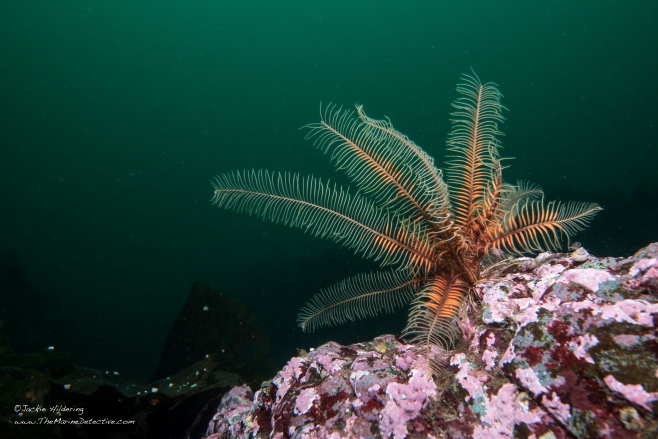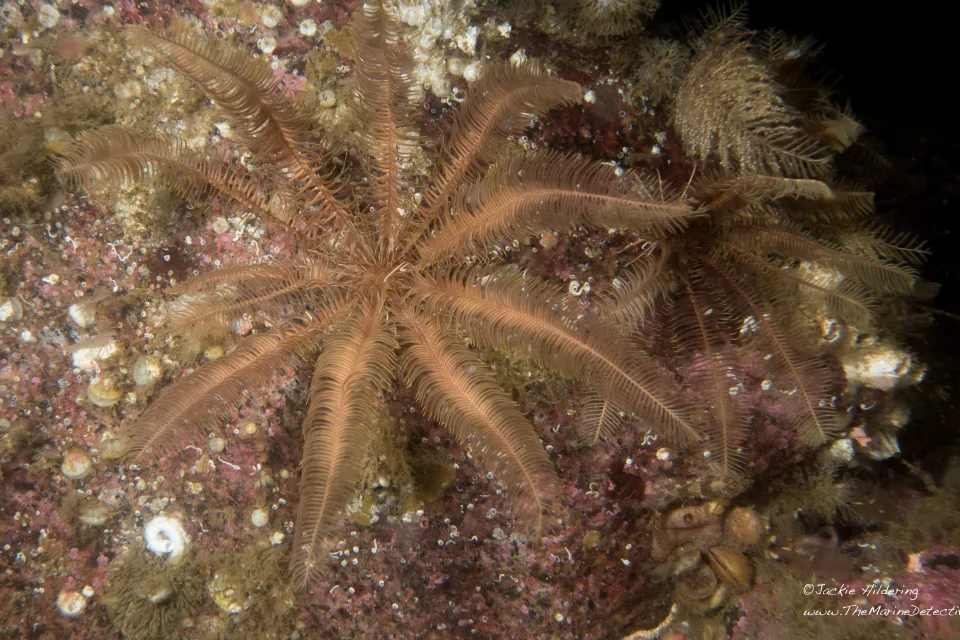Phenomenal Feather Stars
Phenomenal? Yeah they are.
The lineage of “feather stars” (members of the crinoid class) goes back 485 million years, give or take a million. They crawl around. They swim in the most extraordinary way. You’ll see. 🙂
Another non-scientific name used for feather stars is “sea lilies” but I avoid that. As pretty as the name is, I believe it adds to confusion. These are animals, not plants. They are echinoderms, relatives to sea stars, brittle stars, sea urchins and sea cucumbers. Also “sea lily” is a name more often used for the crinoid relatives that have a stalk into adulthood. Only juvenile feather stars have a stalk. Then, get this . . . they detach and crawl down their own stalk to perch directly on the bottom! (Source: A Snail’s Odyssey). See below.

There are many feather star species in the world but the detail here is about the species commonly found in shallow water off the coast of British Columbia – Florometra serratissima (range is from the Aleutian Islands to Baja California).
Feather stars have 5 feathery arms that split to form 10 or more arm branches that are used to gather bits of organic matter (snacks) out of the water. With arm’s outreached, Florometra serratissima is up to 25 cm wide and they are up to 31 cm tall. Feather stars also use their arms to swim as recently captured in this video by dive buddy, Brenda Irving. They swim as if “walking up an invisible staircase” (quote from Lamb and Handby).
Phenomenal – right?
The following detail on their locomotion is largely compiled from the brilliant resource “A Snail’s Odyssey“ by Tom Carefoot, Professor Emeritus, Department of Zoology, University of British Columbia.
How do they swim?
“Florometra serratissima is the only swimming species of crinoid on the west coast of North America. It swims by graceful undulation of its arms in 3 sets, each set moving successively but overlapping. Thus, while about one-third of the arms are in power stroke, another third are in recovery, and the last third somewhere in between. During the power stroke the arms extend out maximally for greatest frictional resistance, while during the recovery stroke they bend inwards to minimise resistance.”
“The sets comprise two triplets and one quadruplet, are their composition with respect to specific arms is invariable (see sequence below). In the scenario shown, swimming is initiated by the blue triplet making a downstroke, followed 1sec later by the green quadruplet, and 2 seconds later by the orange triplet. An entire sequence is completed, then, in about 3 seconds, and the pattern may be repeated for up to 30 seconds.” (Source: A Snail’s Odyssey).

After several strokes to move vertically (to a mean height of 29 cm at an average speed of 5.4 cm/sec), individuals often turn 90 degrees and swim horizontally. If there is current, they will swim with the current. Horizontal swimming is achieved by the 5 arms furthest away from the bottom making stronger downward pulses than the arms closest to the bottom. (Source: Shaw and Fontaine. See Figure 3 at this link if you wish to better understand the horizontal movement).
Swim speed was found to occur in “short, repeatable bursts of 10 to 30 seconds. Continuous swimming beyond 4 minutes provokes a refractory period lasting 5 to 17 minutes during which individuals are incapable of swimming.” (Source: Shaw and Fontaine).
Feather stars end up back on the ocean bottom by stopping movement, and then “parachuting” down (as can be seen at the end of the video above).
Swimming and crawling can be stimulated by current and touch from predators such as Sunflower Stars (Pycnopodia helianthoides) and crabs. Research supports that if touched by a Sunflower Star, there is about a 5 second delay followed by “several power strokes carrying the stimulated individual 1 to 3 metres away. This cycle can be repeated several times and capture by a sea star is actually thought to be rare.” (Source: A Snail’s Odyssey).

Particles of food are captured by the pinnules, moved by tube feet and cilia and form a bolus, which is moved down a “food grove” toward the mouth. This delicate looking animal has to be strong enough to be in high current areas as that’s where the feeding is good. The cirri hold on to surfaces and allow the Feather Star to crawl. ©2019 Jackie Hildering.
Yes, they also crawl!
Crawling has been found to be feather stars’ main means of getting around with swimming being only in response to a predator or touch.
“Stalkless crinoids such as Florometra serratissima anchor to the substratum [ocean bottom] using flexible cirri [these have been described as holding on like bird’s feet do]. The cirri are jointed and can slowly bend and straighten. . . . ” (Source: A Snail’s Odyssey).
The arms are also involved in crawling around. The 10 arms attach to the bottom with small hooks, the central part of the feather star’s body (the calyx and cirri) is lifted. “The arms then contract and extend on opposite sides of the body, which moves it in one direction or the other. Repetition of this behaviour will gradually move the individual to a new location.” (Source: A Snail’s Odyssey)
What a remarkable species with relatives dating back 485 million years and defences including: (1) being able to regenerate arms; (2) having a body that has little nutritional content, is hard, and may taste bad AND; (3) is strong enough to withstand the current that delivers snacks, but light enough to allow swimming as an escape response.

Above: Feather star near Telegraph Cove at about 10 m depth. Species reported to be from 10 to 1252 m. Believe this to be a female! From A Snail’s Odyssey: “Studies on feather stars Florometra serratissima at Bamfield Marine Sciences Centre, British Columbia mostly have separate sexes, but a small percentage is hermaphroditic. Breeding is continuous throughout most of the year and “dribble” spawning is the norm. Gonads appear as swellings on special pinnules of the arms, known as genital pinnules. Genital pinnules occur on all 10 arms, but concentrate in the lower third of each arm. Male individuals can be recognised by the creamy white colour of their genital pinnules, and females by pink or orange-coloured pinnules.” More detail on reproduction of feather stars at this link. Photo ©2019 Jackie Hildering.

Above: This remarkable photo by Neil McDaniel shows an individual with eggs (orange) and allows you to see the incredible fine details of the “feathers” – the pinnules of Florometra serratissima.

Above: Another fantastic capture by Neil McDaniel. Florometra serratissima climbing down his/her stalk to live an an adult, moving around on its cirri and swimming.

Round Lipped Boot Sponge (1 m tall) near Powell River, festooned with feather stars (Florometra serratissima). Also, see the juvenile Giant Sea Cucumbers?

Feather stars at the same site as the individual in the video – the Knight Inlet Sill. Animals to the right are brachipods. ©2019 Jackie Hildering.

Above: Dive buddy, Brenda Irving, just before taking the video above. Here with the coral Primnoa pacifica which is usually found at great depth but the upwellings at this site in Knight Inlet lead to it occurring much shallower too, up to ~15 m. The animals on the coral in this image are Orange Hermit Crabs. Detail on this species of coral and this extraordinary site can be read at “A Proposal to Create a Marine Refuge at the Knight Inlet Sill, British Columbia to Protect Unique Gorgonian Coral Habitat” by Neil McDaniel. Click here.
Sources:
- Biodiversity of the BC Coast; Common feather star
- Crinoids in Earth History
- Lamb, Andy, and Bernard P. Hanby. 2005. Marine Life of the Pacific Northwest: A Photographic Encyclopedia of Invertebrates, Seaweeds And Selected Fishes. Harbour; 1 edition. http://knowbc.com/marinelife/Books/Marine-Lifeof-the-Pacific-Northwest.
- McDaniel, Neil. 2018.A Proposal to Create a Marine Refuge at the Knight Inlet Sill, British Columbia to Protect Unique Gorgonian Coral Habitat
- Shaw, G. D., and Fontaine, A. R. 1990. The locomotion of the comatulid Florometra serratissima (Echinodermata: Crinoidea) and its adaptive significance. Canadian Journal of Zoology 68:942–950
- A Snail’s Odyssey
- Learn About Feather Stars: Attachment & locomotion
- Learn About Feather Stars: Reproduction & development
- Learn About Feather Stars: Feeding & growth
- Learn About Feather Stars: Regeneration
- Learn About Feather Stars: Predators & defenses

4 Responses to “Phenomenal Feather Stars”
Unspeakably beautiful picture 5th down where the feather stars are festooning! They look so delicate but from all your wonderful information, they seem strong enough to survive well. Thanks for posting this.
This is a fabulous post! Thanks so much for doing this in an ongoing way! All the best, Evie Chauncey
fantastic How little i know about all this thank you so much Jackie.
Omg, what indepth (pun intended) sharing of info, I was moved to tears watching the feather star swim. They do not know what they are up against. What is the procedure for approval of refuge application?